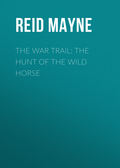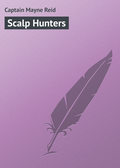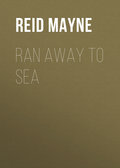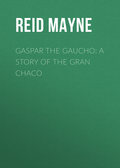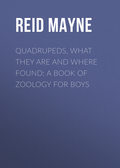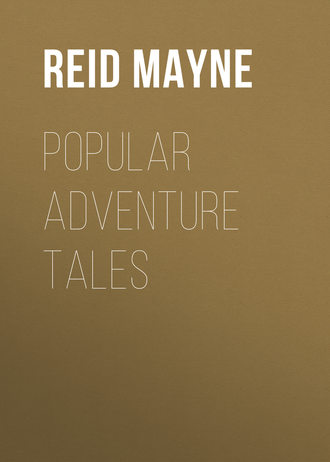
Майн Рид
Popular Adventure Tales
CHAPTER XLIV.
A FIGHT BETWEEN TWO VERY SCALY CREATURES
When they awoke in the morning they found Guapo busy over the fire. He had already been at the turtles' nests, and had collected a large basketful of the eggs, some of which he was cooking for breakfast. In addition to the eggs, moreover, half-a-dozen large turtles lay upon their backs close by. The flesh of these Guapo intended to scoop out and fry down, so as to be carried away as a sort of stock of preserved meat; – and a very excellent idea it was. He had caught them during his watch as they came out of the water.
All the turtles had gone off, although this is not always the case; for frequently numbers that have not finished covering their eggs during the night may be seen hard at work in the morning, and so intent on it, that they do not heed the presence of their worst enemies. These the Indians denominate “mad tortoises.”
This morning, however, no “mad tortoises” were to be seen; but when our travellers cast their eyes along the beach they saw quite a number that appeared to be turned upon their backs just like those that Guapo had capsized. They were at some distance from the camp, but curiosity prompted our travellers to walk along the beach and examine them. Sure enough there were nearly a dozen large tortoises regularly laid on their backs, and unable to stir; but, besides these, there were several tortoise-shells out of which the flesh had been freshly scooped, and these were as neatly cleaned out as if the work had been done by an anatomist. All this would have been a mystery but for the experience of Guapo; but Guapo knew it was the jaguar that had turned the tortoises on their backs, and that had cleaned out and eaten the flesh from the empty shells!
Now, it is no easy thing for a man, provided with the necessary implements, to separate the flesh of a tortoise from its shell, and yet the jaguar, with his paw, can in a few minutes perform this operation most adroitly, as our travellers had full proof. All that they saw had been done that same night; and it gave them no very pleasant feeling to know that the jaguar had been at work so near them.
This animal, as Guapo said, in attacking the turtles, first turns them over, so as to prevent their escape – for the “carapas” are of those tortoises that once upon their backs on level ground cannot right themselves again. He then proceeds to tear out the flesh, and eats it at his leisure. Oftentimes he capsizes a far greater number than he can eat, and even returns to the spot to have a second meal of them; but frequently the Indians wandering along the river, find the tortoises he has turned over, and of course make an easy capture of them.
Guapo, upon this occasion, took advantage of the jaguar's skill, and carried to the camp all that the latter had left. It was Guapo's design to make a large quantity of “turtle sausage-meat,” so that they might have a supply for many days, as by this time even Guapo himself was getting tired of the horse-flesh “charqui.”
They were about returning to camp, when their attention was drawn to two dark objects upon the sand-beach a little farther on. These objects were in motion, and at first they believed they were a pair of “mad tortoises” that had not yet returned to the water, although they were close to its edge.
Led on by curiosity our party approached them, and saw that one only was a tortoise, and one of the largest kind, being nearly three feet in diameter. The other animal was a small caïman or alligator.
As our travellers drew near they saw that these two creatures were engaged in a fierce and deadly combat. Now, it is a curious fact that the larger alligators and crocodiles are among the most destructive enemies which the turtles have, eating thousands of the latter while they are still tiny little creatures and unable to defend themselves; and, on the other hand, that the turtles prey extensively on the young of both alligators and crocodiles, eating them whenever they can catch them! I say this is a curious fact in natural history, and it seems a sort of retaliatory principle established between these two kinds of reptiles, as if they ate one another's offspring en revanche.
There is no feeling of revenge, however, in the matter. It is merely an instinct of appetite by which both kinds will eat almost any small fry they come across. In fact, the alligators and crocodiles not only eat the young of the turtles, but their own young as well. That is, the old males do; and it has been stated, that the males of some species of tortoises have a similar unnatural appetite.
The turtle of which we are speaking is one of the most carnivorous of the whole race, and one of the fiercest in its nature too; so much so, that it has earned the name of the “fierce tortoise.” It will eat fish and small crustacea, and almost any living thing it finds in the water, which is not too large for it. It is extremely expert in catching its prey. It lies concealed at the bottom among the roots of flags and nymphæ; and when any small fish chances to pass it, by means of its long neck darts out its head and seizes upon its unsuspecting victim. Once the bill of the “fierce turtle” has closed upon any object its hold is secure. You may cut its head off, but otherwise it cannot be forced to let go, until it has either captured its prey or taken the piece with it. It will “nip” a stout walking-cane between its mandibles, as if it was no more than a rush.
A very good story is told of a thief and a tortoise. The thief was prowling about the larder of an hotel in search of plunder, when he came upon a large market-basket filled with provisions. He immediately inserted his hand to secure the contents, when he felt himself suddenly seized by the fingers, and bitten so severely, that he was fain to draw back his hand in the most hasty manner possible. But along with the hand he drew out a “snapping” turtle. To get rid of the “ugly customer” was his next care; but, in spite of all his efforts, the turtle held on, determined to have the finger. The scuffle, and the shouts which pain compelled the thief to give utterance to, awoke the landlord and the rest of the household; and before the thief could disengage himself and escape, he was secured and given into custody.
Well, it was just a tortoise of this species, a “snapping turtle,” and one of the largest size, that our travellers now saw doing battle with the caïman. The caïman was not one of large size, else the turtle would have fled from it, not that even the largest caïmans are feared by the full-grown carapas. No; the strong plate-armour of the latter protects them both from the teeth and tail of this antagonist. The jaguar, with his pliable paws and sharp subtle claws, is to them a more dreaded assailant than the crocodile or caïman.
The one in question was some six or seven feet long, and altogether not much heavier than the turtle itself. It was not for the purpose of eating each other they fought. No – their strife was evidently on other grounds. No doubt the caïman had been attempting to plunder the new-laid eggs of the tortoise, and the latter had detected him in the act. At all events, the struggle must have been going on for some time, for the sand was torn up, and scored, in many places, by the sharp claws of both.
The battle appeared to be still at its height when our party arrived on the spot. Neither tortoise nor caïman paid any attention to their presence, but fought on pertinaciously. The aim of the caïman appeared to be to get the head of the tortoise in his mouth; but whenever he attempted this, the latter suddenly drew his head within the shell, and repeatedly disappointed him. The tortoise, on its part, rose at intervals upon its hind-feet, and making a dash forward, would dart forth its long neck, and clutch at the softer parts of its antagonist's body just under the throat. Several times it had succeeded in this manœuvre, and each time it had brought the piece with it, so that the caïman was already somewhat mangled. Another manœuvre of the tortoise was to seize the tail of its antagonist. Instinct seemed to teach it that this was a vulnerable part, and for the purpose of reaching the tail, it constantly kept crawling and edging round towards it.
Now, there is no movement so difficult for a reptile of the crocodile kind as to turn its body on dry land. The peculiar formation of the vertebræ, both of its neck and spine, renders this movement difficult; and in “changing front,” the reptile is forced to describe a full circle with its unwieldy body – in fact to turn “all of a piece.” The tortoise, therefore, had the advantage, and, after several efforts, he at length succeeded in outflanking his antagonist, and getting right round to his rear. He lost no time, but, raising himself to his full height and making a dart forward, seized the tail and held on. He had caught by the very tip, and it was seen that his horny mandibles had taken a proper hold.
Now commenced a somewhat ludicrous scene. The caïman, though but a small one, with the immense muscular power which he possessed in his tail, if not able to detach his antagonist, was able to give him a sound shaking, and the turtle was seen vibrating from side to side, dragged along the sand. He held his broad yellow feet spread out on all sides, so as to preserve his equilibrium, for he well knew that to lose that would be to lose his life. Should he get turned on his back it would be all over with him; but he carefully guarded against such a fatal catastrope. Of course there were intervals when the caïman became tired, and remained still for a moment; and at each of these intervals the tortoise renewed his hold, and, in fact, as our party now perceived, was slowly, though surely, eating the tail!
When this had continued a short while, the great saurian seemed to despair. The pain, no doubt, caused him to weep “crocodile's tears,” though none were seen, but his eyes glared with a lurid light, and he began to look around for some means of escape from his painful position. His eye fell upon the water. That promised something, although he knew full well the turtle was as much at home there as he. At all events, his situation could not be a worse one, and with this, or some such reflection, he made a “dash” for the water. He was but a few feet from it, but it cost him a good deal of pulling and dragging, and clawing the sand, before he could get into it. In fact, the tortoise knew that its position could not be benefited by the change, and would have preferred fighting it out on dry land, and to do this he set his claws as firmly as possible, and pulled the tail in the opposite direction!
The strength of the caïman at length prevailed. He got his body into the water, and, with a few strokes of his webbed feet, jerked the turtle after, and both were now fairly launched. Once in the river, the caïman seemed to gain fresh vigour. His tail vibrated violently and rapidly, throwing the tortoise from side to side until the foam floated around them, and then both suddenly sank to the bottom.
Whether they continued “attached,” or became “separated” there, or whether the turtle killed the lizard, or the lizard the turtle, or “each did kill the other,” no one ever knew, as it is highly probable that no human eye ever saw either of them again.
At all events, no one of our party saw any more of them; and, having watched the surface for some time, they turned in their steps and walked back to the camp.
CHAPTER XLV.
A PAIR OF VALIANT VULTURES
They had got into a part of the river that seemed to be a favourite resort with turtles and crocodiles, and creatures of that description. At different times they saw turtles of different kinds; among others, the “painted turtle,” a beautiful species that derives its name from the fine colouring of its shell, which appears as if it had been painted in enamel. Of crocodiles, too, they saw three or four distinct species, and not unfrequently, the largest of all, the great black crocodile (Jacare nigra). This was sometimes seen of the enormous length of over twenty feet! Terrible-looking as these crocodiles are, they are not masters of every creature upon the river. There are even birds that can sorely vex them, and compel them to take to the water to save themselves from a fearful calamity – blindness.
One day, while descending the river, our travellers were witness to an illustration of this.
They were passing a wide sand-bank that shelved back from the river, with a scarcely perceptible slope, when they saw, at a distance of about two hundred yards from the water's edge, a crocodile making for the river. He looked as though he had just awoke from his torpid sleep, for his body was caked all over with dry mud, and he seemed both hungry and thirsty. It was like enough he was coming from some inland pond, where the water had dried up, and he was now on his way to the river.
All at once two dark shadows were seen passing over the white surface of the sand-bank. In the heaven two large birds were wheeling about, crossing each other in their courses, and holding their long necks downwards, as if the crocodile was the object of their regard.
The latter, on seeing them, paused; and lowered his body into a squatted or crouching attitude, as if in the birds he recognised an enemy. And yet what could such a large creature fear from a pair of “king-vultures?” for king vultures they were, as was easily seen by their red-orange heads and cream-coloured plumage. What could a crocodile, full ten feet long, fear from these, even had they been eagles, or the great condor himself? No matter; he was evidently frightened at them; and each time that they drew near in their flight, he stopped and flattened his body against the sand, as if that might conceal him. As soon as they flew off again to a more distant point of their aërial circle, he would once more elevate himself on his arms, and make all haste toward the water.
He had got within about an hundred yards of the river, when the birds made a sudden turn in the sky, and swooping down, alighted upon the sand directly before the snout of the crocodile. The latter stopped again, and kept his eyes fixed upon them. They did not leave him long to rest; for one of them, making a few hops towards him, came so close, that it might have been supposed the crocodile could have seized it in his jaws. This, in fact, he attempted to do; but the wary bird threw up its broad wings, and flapped to one side out of his reach.
Meanwhile, the other had hopped close up to his opposite shoulder; and while the crocodile was engaged with the first one, this made a dash forward, aiming its great open beak at the eye of the reptile. The crocodile parried the thrust by a sudden turn of his head; but he had scarcely got round, when the second vulture, watching its opportunity, rushed forward at the other eye. It must have succeeded in pecking it, for the great lizard roared out with the pain; and rushing forward a bit, writhed and lashed the sand with his tail.
The vultures paid no attention to these demonstrations, but only kept out of the way of the teeth and claws of their antagonist; and then, when he became still again, both returned to the attack as before. One after the other was seen dashing repeatedly forward – using both legs and wings to effect their object, and each time darting out their great beaks towards the eyes of the reptile. The head of the latter kept continuously moving from side to side; but move where it would, the beaks of the vultures were ready to meet it, and to pierce into the sockets of those deep lurid eyes.
This terrible contest lasted all the time the balza was floating by. It was a slow current at this place, and our travellers were a long time in passing, so that they had a good opportunity of witnessing the strange spectacle. Long after they had glided past, they saw that the conflict continued. They could still perceive the black body of the reptile upon the white sand-bank, writhing and struggling, while the flapping wings of the vultures showed that they still kept up their terrible attack. But the head of the crocodile was no longer directed towards the water.
At the first onset the reptile had used every effort to retreat in that direction. He knew that his only safety lay in getting into the river, and sinking beyond the reach of his adversaries. At every interval between their assaults, he had been seen to crawl forward, stopping only when compelled to defend himself. Now, however, his head was seen turned from the water; sometimes he lay parallel with the stream; and sometimes he appeared to be heading back for the woods, while his struggles and contortions betrayed the agony he was undergoing. But his turning in this way was easily accounted for. He knew not in what direction lay the river. He could no longer see. His eyes were mutilated by the beaks of the birds. He was blind!
Guapo said the vultures would not leave him until they had made a meal of his eyes, and that was all they wanted. He would then remain on shore, perhaps without finding his way back to the water, and most likely be attacked by jaguars, or other preying creatures, who could conquer him the easier now that he was deprived of his sight!
As the balza glided on, Guapo told our travellers many strange stories of crocodiles. He stated, what is well known to be true, that in the rivers of South America many people are every year killed by these ravenous creatures; in fact, far more than have ever fallen victims to the salt-sea sharks. In some places they are much fiercer than in others; but this may arise from different species being the inhabitants of these different places. There is the true crocodile, with long sharp snout, and large external tusks; and the caïman, with a snout broader and more pike-shaped; and the former is a much more courageous and man-eating creature. Both are often found in the same river; but they do not associate together, but keep in distinct bands or societies; and they are often mistaken for each other.
This may account for the difference of opinion that exists in regard to the fierceness of these reptiles – many asserting that they are utterly harmless, and will not attack man under any circumstances; while others, who have witnessed their attacks, of course bearing testimony to the contrary. There are many places in South America, where the natives will fearlessly enter a lake or river known to be full of crocodiles, and drive these creatures aside with a piece of a stick; but there are other districts where nothing will tempt an Indian to swim across a river infested with these reptiles. In the Amazon districts, in every Indian village, several people may be seen who have been maimed by crocodiles. No wonder that among author-travellers there should be such a difference of opinion.
Guapo stated, that when an Indian has been seized by a crocodile in its great jaws, he has only one chance of escape, and that is, by thrusting his fingers into the eyes of the reptile. This will invariably cause it to let go its hold, and generally frighten it, so as to enable the person to escape. It, of course, requires great presence of mind to effect this, as the person who has been seized will himself be in great pain from the tearing teeth of the monster, and, perhaps, will have been drawn under the water, before he can gather his senses. But it has often occurred that Indians, and even women, have escaped in this way.
The eyes of the crocodile are its most tender parts, – in fact, the only parts that can be made to feel pain. A crocodile may be disabled by cutting at the root of its tail, but it can only be frightened by an attack upon the eyes; and this appears to be a well-known fact, not only to the Indians, but to all its other enemies among the birds and quadrupeds.
The young crocodiles are often attacked, and have their eyes pecked out, by the small gallinazo or “zamuro” vultures just in the same way that we have seen one of a larger size become the victim of the more powerful king vultures.



